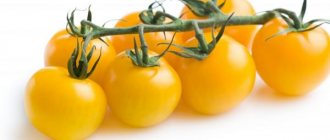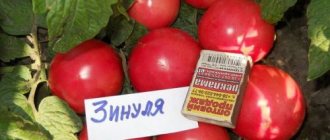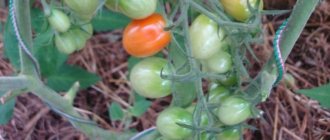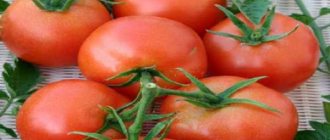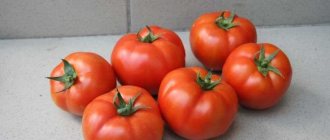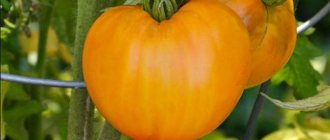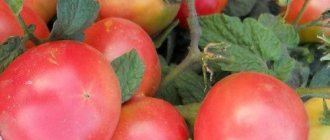The desire of every gardener is to obtain a good harvest, regardless of climatic conditions and soil fertility. Thanks to the work of scientific breeders from Siberia, the tomato variety “Pearl of Siberia” was introduced to the market. The artificially bred variety guarantees consistently good yields, despite unfavorable weather conditions. Due to its good resistance to cold, the tomato is especially popular in northern regions, with a short and not too warm summer period.
Open ground tomatoes in Siberia:
Description of the variety
Fruit:
- Slightly elongated, cylindrical in shape, reminiscent of a dense thick barrel;
- Those that have not reached varietal maturity are pale green in color. As ripeness increases, they begin to turn brown and eventually acquire a bright red color;
- With smooth, dense, thin skin;
Fruits with dense, but soft, tender pulp, with numerous seeds and a rich tomato-sweet taste.
- Number of seed chambers 2-3;
- Average dry matter content;
- They reach approximately 10 cm in length;
- Average weight is from 100 to 120 grams.
Bushes:
- Indeterminate, non-standard plant. With a powerful branched root system and an abundantly leafy, strong stem;
- Reaches more than 1.5 meters in height;
- The leaves are medium-sized, potato-type, dark green in color, with a wrinkled structure;
- The inflorescence is simple, intermediate type. The formation of the first inflorescence occurs above the 9th leaf.
The best tomato varieties for the Urals and Siberia:
Tomatoes Pearl: Siberia, Yellow, Red, Pink
The Pearl tomato has more than 5 different types, each worthy of special attention.
Description of Pearl tomatoes
Characteristic
Pearl is a relatively new type of tomato. It is grown both in greenhouses and in open ground, the main thing is constant watering and fertilization. This type of tomatoes is classified as decorative. The plant loves sunny and warm places.
The bushes are small in size, 30-40 cm. The growth of the plant at the time of ripening depends on the size of the pot in which the tomatoes are kept. Pearl tomatoes come in the following types:
- pearls of Siberia;
- yellow pearl;
- red pearls;
- pink pearl.
Features of the view
Each type from this family has a number of differences:
- productivity;
- unpretentiousness;
- excellent taste;
- Red color;
- resistance to diseases;
- ease of cultivation.
Pearl of Siberia
The Pearl of Siberia is a new type of tomato bred in this region. It is famous for its high yield and excellent taste. It is grown using seeds and is not a hybrid type. The Pearl of Siberia has a strong and strong root system, which makes it possible to grow in any conditions and still produce a good harvest; the entire system develops in width.
The bush grows to almost 145 cm, the stem is strong and powerful, and has several clusters with fruits. The leaves of this plant are small in size, shaped like potatoes, and dark green.
The variety gives good yield: on average, more than 8 fruits are obtained from one gem. Ripening is average, the first fruits are obtained after 110 days. The description of tomatoes is simple: they are round, tasty, and easy to grow.
The ripening process is interesting: first the lower and then the upper fruits ripen. The plant has good immunity, which facilitates the growing process
Red Pearl
This variety is suitable for growing at home
The fruits have a decorative basis; they are grown both in gardens and at home on the windowsill. The red pearl grows small, maximum 34-45 cm. The fruits are small, somewhat reminiscent of cherry tomatoes. One fruit weighs 25-35 g. The total number of chambers reaches 2, the percentage of dry substances is not higher than 6%.
The downside is that such tomatoes do not last long after assembly, so it is impossible to transport the product over long distances.
The variety perfectly combines acid and sugar. More than 1.5 kg is collected from one bush, and from 4 bushes per 1 sq. m receive over 6 kg. According to the description, the advantages of the variety are:
- the ability to grow tomatoes at home;
- fast ripeness;
- adaptability to lack of lighting;
- ability to withstand sudden temperature changes;
- resistance to diseases;
- ease of care.
Yellow pearl
Yellow pearls are mini tomatoes. The fruits of this garden crop are yellow. The plant is unpretentious and easy to grow. The main thing is to water it on time and sometimes give additional vitamins and fertilizers. Yellow pearl is a determinate hybrid.
The fruits ripen quickly, from the moment of planting to the moment of harvesting, 84-94 days pass. The plant is low: maximum height - 61 cm, minimum - 35 cm. It all depends on which parents are chosen for it. Mature fruits are bright yellow in color, round and small in shape.
The weight of one fruit is 20-35 g. It is recommended to tie the bushes to lighten the load on the plant. Positive characteristics of the variety:
- good resistance to lack of light;
- ability to withstand sudden temperature changes without loss of yield;
- high percentage of resistance to diseases and pests.
pink pearl
Pink Pearl is a determinate variety with early ripening. From planting to harvest it takes 82 to 86 days. The bushes grow small: 65-75 cm in height. Fully ripened fruits have a pinkish tint with red dots. Their weight ranges from 91 g to 95 g.
Indoor tomatoes Growing tomatoes in winter Open ground tomatoes in Siberia
One fruit contains 2-3 chambers; the bush contains a total of 5% dry matter. Pink Pearl tomatoes are an excellent choice for yield. Advantages of the plant:
- adaptability to any conditions;
- undemanding to lighting;
- resistance to temperature changes;
- immunity to diseases and pests.
The branches cannot withstand the load, so they are tied up. The plant is constantly watered and given calcium and vitamins. Growing varieties is easy and simple.
Tomatoes: advantages and disadvantages
The Pearl of Siberia tomato has a number of advantages:
- Low maintenance requirements;
- High productivity;
- Long-term fruiting;
- Pleasant taste characteristics;
- Ability for long-term storage;
- Resistant to cracking;
- Excellent immunity to common diseases and insect pests;
- Good transportability.
No deficiencies were identified in the variety during cultivation.
Characteristics
Breeders classify the tomato Pearl Janet as a late-ripening variety.
From the moment of germination to the onset of biological maturity, at least 130 days pass. Nevertheless, our gardeners claim that they manage to ripen in 110-130 days and are medium late. In any case, you need to grow Janet’s Pearl tomatoes using seedlings. The first ripe fruits can be removed from the bush no earlier than the end of July. Fruiting is somewhat extended. As a rule, under favorable weather conditions, bright tomatoes can be harvested until mid-September.
The productivity of tomato variety Zhemchuzhina Janet is high, up to 15 kg/sq. m. It is greatly influenced by weather conditions and compliance with agricultural technology rules.
- lack of moisture and nutrients will not allow the plant to set a large number of ovaries and the fruits to reach their maximum size;
- dense plantings, untimely removal of stepchildren and extra shoots, lack of ventilation in the greenhouse not only leads to yield losses, but also reduces immunity to such a formidable disease as late blight.
Like most yellow and orange varieties, Pearl Janet tomatoes are not suitable for pickling. But they make excellent winter salads and sauces. But it is best to eat them fresh, because the pulp of tomatoes contains a lot of vitamins and microelements.
"Pros and cons"
Reviews about Janet's Pearl tomatoes are mixed. Among gardeners there are many fans of this variety, who note the following advantages first of all:
- high productivity;
- large fruits of unique color;
- high taste qualities;
- resistance to most diseases, including late blight.
The variety also has disadvantages:
- a tall variety with heavy tomatoes on the branches requires constant tying and support;
- short shelf life;
- relatively expensive seeds, considering that there will be a maximum of 5 pieces in a bag.
All the characteristics of the Janet Pearl tomato indicate that the main bet on them should not be made. But, as a rule, vegetable growers who grow tomatoes select from five to ten varieties with different ripening periods and differing in purpose. Among them there is a worthy place for tomatoes of the Pearl Janet variety.
Growing tomatoes
Experienced vegetable growers do not recommend sowing seeds directly into the ground, but using the seedling method.
How to prepare seeds:
- Before sowing, the seed material is disinfected and treated in a growth stimulator;
- It is advisable to sow seeds in germinated form. To do this, they are placed in damp germination material.
Sowing seed material:
- Seeds are sown for seedlings in early March;
- The soil for growing seedlings is disinfected and warmed to room temperature;
- You can choose any containers. But it is better to give preference to containers with a good drainage system;
- Planting material is sown at intervals of 1-2 cm, deepening by 1 cm;
- The planted seeds are covered with a film to create a certain humidity underneath;
- As soon as shoots appear, the film should be removed. To obtain strong seedlings, they are provided with good lighting. Therefore, additional lighting is used;
- Seedlings are picked as soon as two true leaves form;
- Water carefully, trying not to get water on the leaves. The seedlings are also fed with mineral fertilizers;
- To make the seedlings easier to adapt to new conditions, they are hardened off within two weeks.
In specialized stores you can purchase universal soil for tomatoes.
Rules for planting seedlings:
- Tomato seedlings are transplanted to a permanent place when they reach the age of 50 days and a length of approximately 20 cm;
- The soil in the greenhouse structure is dug up with last year’s humus and treated with antimicrobial agents;
- Planting is carried out in planting holes located in a row, with an interval of 50 cm. The row spacing is maintained at approximately 70 cm;
- The planted bushes are watered at the root.
Features of cultivation and storage
Tomatoes are grown through seedlings. To prevent the sprouts from stretching, after germination they are taken out for a week in a room where the temperature does not rise above 18 °C. Hardened plants get sick less often, stems and roots become stronger. Indeterminate varieties are characterized by vertical development of the root system, so 1 m² is enough food for 4 plants.
Germinated seeds germinate faster.
Pearl of Siberia tomatoes are good for storing in storage. In an equipped cellar they store their taste and presentation for 1.5-2 months. The room is periodically ventilated, and the fruits are sorted.
Bush care
How to care for tomato plantings:
- Water as needed with warm, settled water. It is necessary to make sure that moisture penetrates deep into the soil and nourishes the root system of the tomato crop. It is advisable to water in the morning. This will allow the plant to dry out at night when the temperature drops;
- Be sure to regularly loosen the soil to ensure stable air exchange. The frequency of the procedure is once every 3-4 days, after watering or precipitation;
- Mulch the soil not often. But if necessary, use black plastic, as this has a good effect on yield;
- The amount of fertilizing is determined by the type of soil. If there is fertile soil, feed the plantings four times during the growing season. It is permissible to use any complex of mineral fertilizers. When the soil is depleted, fertilizers are applied quite often. A deficiency of essential elements causes inhibition of tomato growth;
- Stepchildren breed once every 1.5 weeks. The formation of a bush is carried out in one stem;
- Gartering is a necessary procedure since the plant is quite tall.
The bushes are tied to the trellises with synthetic materials.
How to grow seedlings
Thanks to proper cultivation, seedlings grow strong and healthy. Care is simple and consists of following basic rules.
Seed preparation
Self-collected seed material requires more careful preparation than purchased seed. Initially, seeds are rejected in order to immediately dispose of non-viable specimens. The grains are laid out on the table one at a time and carefully inspected for visible damage. Then they check for emptiness inside. Prepare a saline solution from 1 teaspoon and 1 glass of water, place the seeds in it. Those unsuitable for landing will float to the surface after 10 minutes.
An important stage in the preparation of seed material is disinfection. The healthy growth and development of seedlings depends on this procedure. The seeds are disinfected in a weak solution of potassium permanganate for 25 minutes, then washed with running water.
Before sowing, the seeds are soaked for 10 hours in a growth stimulator. The stimulator not only improves the germination rate, but also improves immunity. The drugs used are Epin, Zircon or Kornevin.
Container and soil
Any container for planting is suitable: when sowing in a common wooden box, you will need to pick the seedlings in the future. If the seeds are placed in individual containers, for example, disposable plastic cups or peat pots, further care of the seedlings is minimized.
The containers are pre-treated with a dark solution of potassium permanganate to protect the seedlings from fungal infections.
Fertile soil is prepared from garden soil mixed with peat, humus and river sand. River sand is added to make the soil lighter. The resulting mixture is mixed with a tablespoon of wood ash to saturate the soil with additional nutrients. The soil is spilled with a hot solution of potassium permanganate to destroy pathogenic flora. After the soil has cooled, it is laid out in planting containers.
Sowing
The seed material is sown to a depth of 1.5 cm, sprinkled with peat on top and lightly compacted. Moisten with warm, settled water from a spray bottle and cover the containers with film so that the seeds germinate faster. Before emergence, the room temperature should be at least +25 degrees.
Seedling care
In a week the first shoots will appear. The containers are immediately moved to the windowsill, and the film is removed. If there is not enough light, the sprouts will stretch and weaken. To prevent this, install additional lighting.
Water as the top soil layer dries out. Use a shallow watering can and warm, settled water. After watering, the soil is loosened superficially to saturate the soil with oxygen.
When two true leaves appear, the seedlings are picked and placed in separate containers. During picking, weak and unhealthy seedlings are disposed of. The remaining plants are transplanted into separate containers along with a lump of earth.
If growth is poor, two weeks after picking, the seedlings are fed with liquid fertilizer for tomatoes.
10 days before transplanting into the ground, the seedlings are hardened off in outdoor conditions. To do this, it is taken out into the open air for 40 minutes, gradually increasing the time every day to 10 hours. The night temperature in the room is reduced to +13 degrees.
Diseases and pests
The tomato variety “Pearl of Siberia” is highly resistant to most diseases, as well as to the main insect pests (aphids, wireworms, cutworms, mole crickets. However, gardeners should always have insecticidal preparations with a diverse spectrum of action in their arsenal. For those who do not want to use pesticides, You can use traditional methods, but it is advisable to follow preventive measures, which include: ensuring proper care of tomato plantings, timely destruction of weeds.
Productivity
On average, the yield from each bush is approximately 3 kg, that is, the yield from 1 m2 reaches 8 kg.
ATTENTION: If the temperature and lighting conditions are violated, the yield is significantly reduced.
Which regions are best to grow in?
The “Pearl of Siberia” variety has been successfully tested in the Novosibirsk region. Therefore, tomato can be grown throughout Russia. “Pearl of Siberia” can be cultivated both in greenhouses and in unprotected soil.
Reviews about the variety from those who planted
Tomato varieties of Siberian selection always delight gardeners, and “Pearl of Siberia” is no exception. Thanks to its good characteristics, the popularity of the variety is increasing. Distinctive features include gradual ripening of the fruits, first the lower ones, then the upper ones.
The variety “Pearl of Siberia” has become a real favorite among tomato crops. Having excellent immunity makes the growing process easier. Tomato guarantees a stable harvest in unprotected and protected soil.
